prepare for your driving test
It is extremely important to arrive at the test centre at least 15 minutes prior to the start time of your test. It is equally important to be well prepared. Whilst much of the preparation is done behind the wheel beside one of our expert instructors there are quite a few things that you can do at home to show the tester that you are ready and that you deserve that all important Full Irish Driving Licence. On arrival at the test centre you merely need to take a seat. Our instructor will wait with you and put you at ease. The tester will then call your name, and that’s it, your test has begun!
You will be asked for your learner permit. You will then be asked some questions on the rules of the road. We strongly recommend that you carefully read all sections of this book, however the questions below are the ones we find get asked most often and will really help you with your study. Read them, learn them, know them!
Rules of the Road Questions
Q1. What shape and colour is a warning sign?
Diamond Shape – Yellow and Black.
Q2. What should always be kept clean on your vehicle?
Lights – Reflectors – Windows – Mirrors – Registration plate.
Q3. What does a single yellow line mean?
Parking prohibited during business hours.
Q4. What should you do when passing animals on the road?
Slow down, give plenty of room, do not sound your horn or rev your engine.
Q5. What marks the beginning of a no-entry street?
Full white line followed by a broken white line.
Q6. Who or what is not permitted to use a motorway?
Learners, motorcycles under 50cc, invalid carriages, horse drawn vehicles, cyclists and pedestrians.
Q7. What does a broken white line mean?
A broken white line means overtake if safe to do so.
Q8. Can you ever reverse from a minor road on to a major road?
NO. (You may only reverse from a major road to a minor road. You must remain very aware of the possibility of following traffic).
Q9. What does a double yellow line mean?
No parking at any time. (Set down permitted)
Q10. What is the sequence of traffic lights??
Green – steady Amber – Red – amber – green
Q11. When should you use your hazard lights?
When your car is broken down, being towed, or at the scene of an accident.
Q12. Where is the only place you would see a flashing red light?
At a controlled level crossing. (Trains)
Q13. What is the rule on entering a roundabout?
Give way to traffic on your immediate right. Keeping the back wheels of the vehicle in front in view at all times!
Q14. Name some places where you should not overtake?
Where you cannot see far enough ahead – too close to junctions – corners- approach to a bend – pedestrian crossings &ndash(zig-zag lines, see Q.29); hatch markings – over a continuous white line, on approach to hump back bridges etc.
Q15. What is a contraflow bus lane?
It is a bus lane that flows in the opposite direction to the traffic.
Q16. What shape and colour is a regulatory sign?
Regulatory signs are round with red and white background with the exception of three: Stop, Yield and the end of speed limit.
Q17. What is the hard shoulder used for?
Emergencies, breakdowns, pedestrians and cyclists.
Q18. When should you use your dipped headlights?
Always
Q19. What does the rules of the road say about sounding your horn?
You should not sound your horn between the hours of 11:00pm and 7:00am except in an emergency.
Q20. What does a Clearway sign mean?
No stopping or parking at the times shown (Buses and taxis excepted.)
Q21. At a pelican crossing what does a flashing amber light mean?
Proceed with caution , giving way to pedestrians who may still be crossing.
Q22. To keep your Vehicle in legal condition, what should you pay attention to?
Brakes – lights – tyres – steering – indicators – wipers – speedometer – horn – silencer.
Q23. What are the minimum lighting requirements on your vehicle? o?
A motor vehicle (except a motor cycle) must be equipped with two headlights (white or yellow), two white side lights (front), two red rear lights, two red rear stop lights, two red rear reflectors, Number plate lighting to the rear and amber directional indicators front and rear.
Q24. What does a steady amber traffic light mean?
You must stop if it is safe to do so.
Q25. How should you approach a green light that has been green from the first time you have seen it?
Approach with caution at a speed which would allow you to stop safely if necessary.
Q26. What are you legally required to have before you can drive on any public road?
You must hold a valid licence (provisional or full) and have your vehicle taxed and insured and NCT’d.
Q27. What does a green traffic light mean?
It is not a right of way, merely a licence to proceed with caution.
Q28. What is the safest way to park your car at night (If parked on a road)?
Passenger side (left) to the kerb with the rear reflectors showing to the following traffic.
Q29. What do Zig – Zag lines on approach to a pedestrian crossing mean ?
Overtaking is prohibited, no set down to let out passengers and no overtaking inside the zone.
Q30. When may you overtake on the left?
When traffic in front is turning right, when you are turning left, when you are on a two lane road where the traffic is slow and the lane on the right is moving slower than the lane on the left.
Q31. How would you recognize a pedestrian crossing at nightime?
Flashing Amber Beacons either side of the Zebra crossing.
Q32. At a pelican crossing what dose a flashing amber light mean?
Proceed with caution giving right of way to pedestrians crossing.
Q33. What is the minimum legal thread depth on a tyre?
1.6 millimeters.
Q34. When should you not drive?
While under the influence of alcohol, drugs (prescribed or otherwise), whilst in an emotional state, whilst injured or unwell or when tired.
Q35. Name places you should not park?
Close to a junction (not within 15mts) –corners – double yellow lines – single yellow lines (within times zones) – opposite a continuous white line (causing other motorists to overtake) or anywhere you would obstruct other road users.
Q36. What should you do if blinded by oncoming lights at night.
Slow down, then look to the left, be aware of pedestrians, cyclists and obstructions on the left. If still blinded slow down more then and stop. Do not put on your own headlights in retaliation.
Q37. What signs would you expect to see when you are approaching a major road?
Warning sign – major road ahead, Regulatory sign – Stop or Yield.
Q38. How would you check your brake lights on your car if you were alone?
Reverse your car towards a window and look at the reflection.
Q39. What are the rules regarding the yellow box junction?
Do not enter a yellow junction box it if you can’t clear it without stopping, except when turning right and not causing an obstruction.
Q40. What is the maximum legal speed limit on (A) Irish Motorways? (B) National Routes? (C) Regional Routes? (D) Towns and Cities?
A 120KPH. B 100KPH C. 80KPH D. 50KPH
Once you have answered a number of these questions you will then be asked the meaning of the various road signs. They are all pictured below and can also be found towards the back of the rules of the road.
Road Signs
Regulatory Traffic Signs
Regulatory signs show the course a driver must follow and an action they are required to take or forbidden to take. They are generally circular and have a red border and black symbols or letters on a white background. Mandatory regulatory signs that indicate the direction traffic must take at junctions are blue and white.
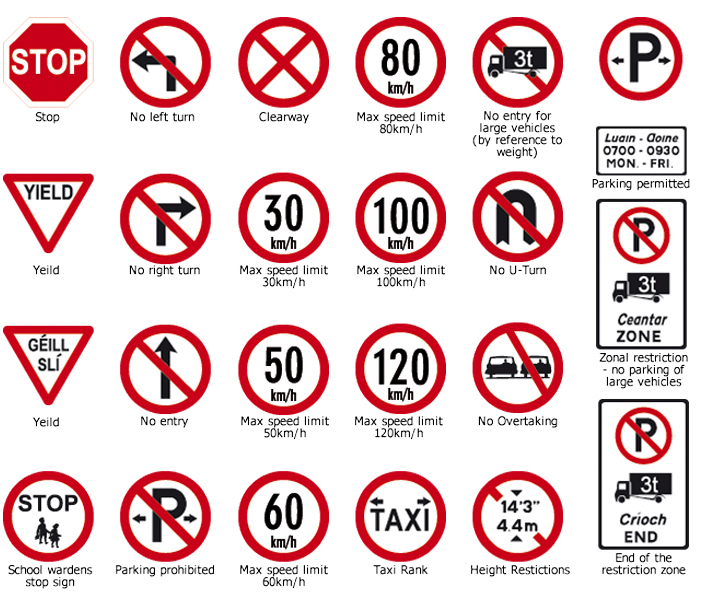
Mandatory Signs at Junctions (White and Blue)
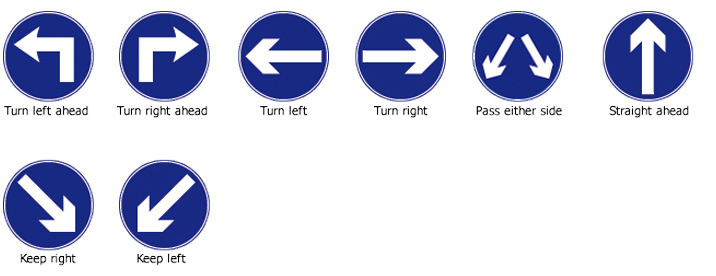
Manual Traffic Control Sign at Roadworks
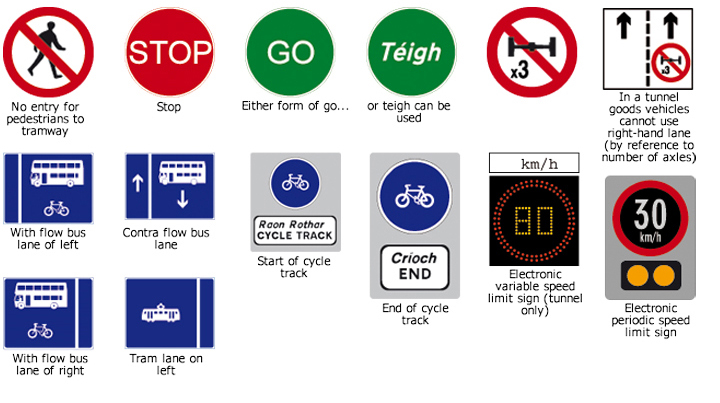
Motorway Signs
These signs are rectangular with blue backgrounds and white writing or symbols.
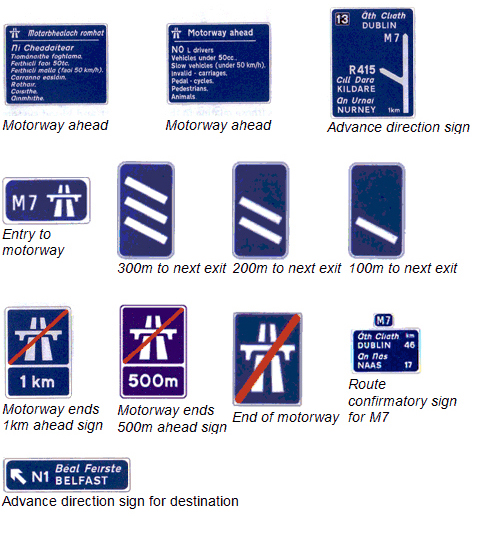
Warning Traffic Signs
This section includes signs that warn road users of a hazard ahead. They are diamond or rectangular in shape and have a black border and black symbols or letters on a yellow background.

Warning Signs for Road Works
Warning signs for road works. These are the same shape as ordinary warning signs but are orange in colour instead of yellow.
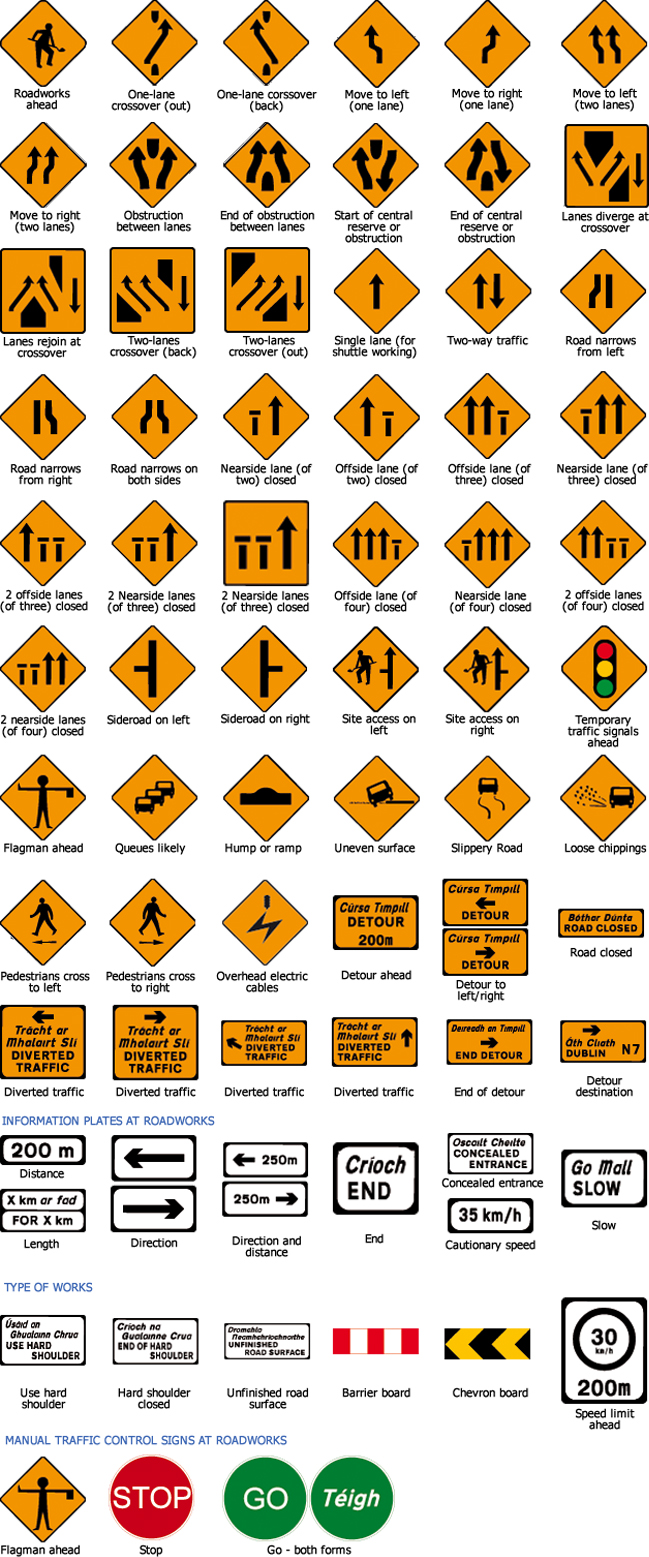
Information Signs
This section includes road signs showing directions and the location of services or other places of interest to tourists.
Advance Direction Signs
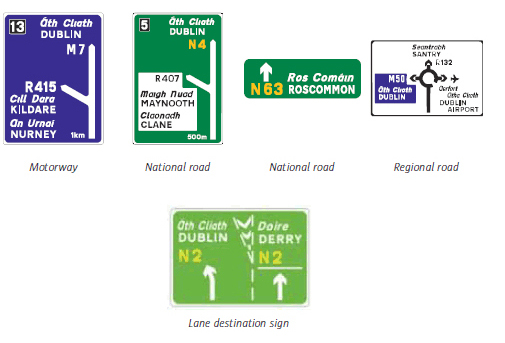
Direction Signs (at junctions)
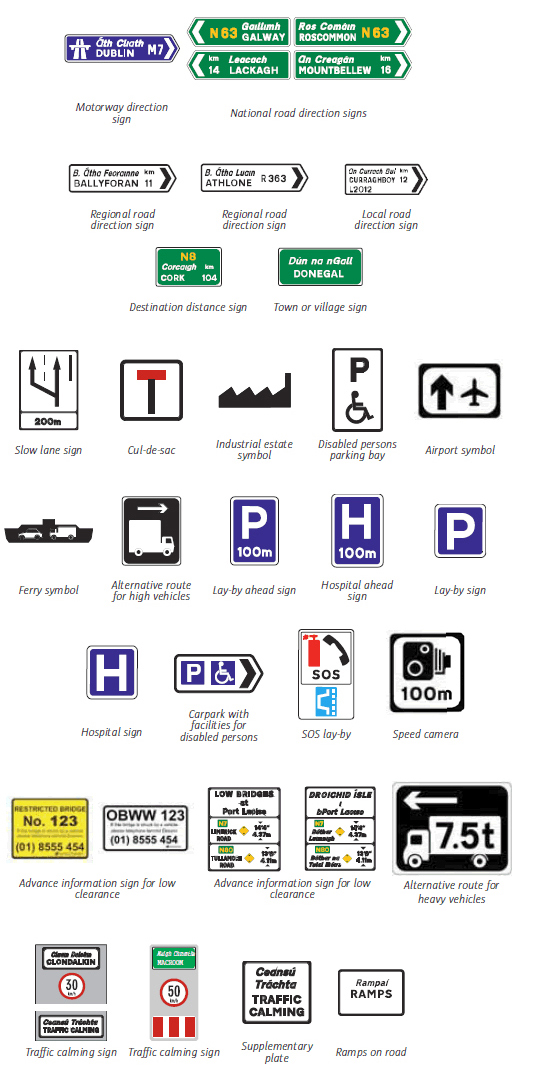
Tourist Information Signs

Once you have answered these questions you will then accompany your tester to your car.
Book Now
Select your Driving Test Date
Go to the online calendar and select the date and time of your actual driving test. Fill in your contact details. If the time of your driving test is not available, please contact us directly to make a booking.
Select service you need
Select the service that suits your needs best or contact us directly if you can't find a package you are looking for. Once your deposit payment has been processed, you are good to go. The balance of payment will be required on the day of your booking. Payments can be made through Credit/ Debit Card or Paypal.
Pass your Driving Test
With our help and a car in perfect condition, you will sail though your Driving Test with Driving Test Car Hire.
What You Get:
Fully insured car in perfect condition
Full checklist rundown
Meet you at your Driving Test Centre
Ultimate Pre-Test Lesson
Practice Driving Test
Fault analysis and correction of driving faults
